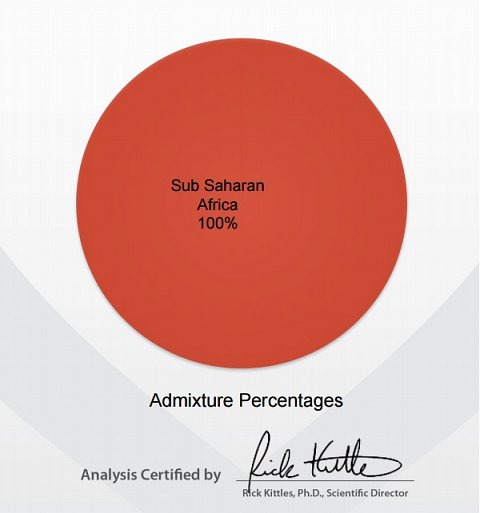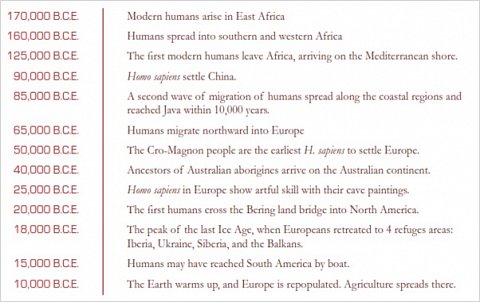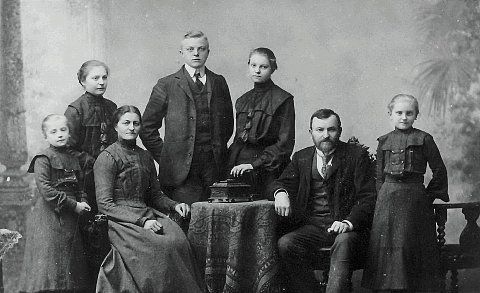-
African Ancestry
review on 4 July 2017
by Guest Author

At a Glance
Summary
The African Ancestry ‘myDNAmix’ test wasn’t quite what I’d imagined it might be. I was glad to find a test that seemed to focus specifically on African heritage, but thought it was a shame that the results provided so little detail. This said, the product information on the website was clear about the limitations of the test, and the results did provide what was described. Their customer service was also excellent and made DNA testing an easy and positive experience.
If you’re looking for an overview of where in the world your DNA comes from or to see if any proportion of it is from somewhere unexpected, then I’d recommend this test. If you’re looking for more detail (e.g. specific areas within Africa), however, there are probably better options.
Full Review
African Ancestry is the only company I’ve seen that focusses its analysis specifically on Africa. It was co-founded by Dr Rick Kittle and Gina Paige in 2003. With Dr Kittle’s experience as a professor at the University of Arizona’s College of Medicine, and Gina Paige’s involvement in several genealogy projects, including helping celebrities research their ancestry, the company has a solid backing. They sell a range of ancestry tests, including those that analyse maternal, paternal and autosomal DNA. I tried out their ‘myDNAmix’ test to see if I had any surprises in my DNA, or whether I was 100% Nigerian, as I predicted I was.
Product Expectations
The website included quite a lot of information about the test. I read that I’d receive information about the different ancestries in my family tree and that my ethnicity would be broken down into continental areas. This was a bit of a disappointment, as the name ‘African Ancestry’ suggested to me that I would learn something about my ancestry within Africa, but from what I could tell, all I was going to learn was whether any of my DNA was from any other continents (I’m Nigerian so I already knew that the majority, if not all, of my DNA was African).
As I read on, I found out that my ethnicity would be assigned to five ethnicities, African, European, Indigenous American, East Asian and Indian. It was made clear in bold text that the test wouldn’t provide me with details about any countries or ethnic groups associated with my DNA.
I was slightly concerned when I read the terms and conditions, as one section seemed to indicate that if African Ancestry couldn’t report on my ethnicity from my DNA for some reason, they would only reimburse me 50% of the fee I had paid. I was pleased, however, to see that my sample would be destroyed after the report was delivered and that my information wouldn’t be passed on to any third parties without my explicit consent.
Ordering Experience
Before adding the test to my cart, I had to tick a box to indicate that I had read and understood the product description, which was a bit of an unusual requirement. Other than that, the ordering process was standard and straightforward. I was pleased to see that shipping was only $6.00 extra, considering that it was being delivered from the US/free.
Once my order had gone through, I received an email confirmation, which included a link to a video. This video featured Gina Paige, the co-founder and president of African Ancestry, explaining what to expect from the next stages of the process. I loved this video introduction, and Gina came across in a warm and friendly way, explaining the experience clearly and without being patronising.
In another video, she demonstrated how to take the swab samples and described exactly what to expect from the report. These videos were one of the highlights of the test for me, and left me feeling prepared and well informed about the whole experience.
The Results
I received an email once my samples had reached the lab, and another once the results were ready, about four weeks later. There were two reports, the ‘myDNAmix Certificate’, showing my admixture percentage, and the ‘myDNAmix Results Manual’.
Results Section: myDNAmix Certificate
The main part of the results was the myDNAmix Certificate, which provided me with the percentages of my DNA that were from each of the different continents. Unsurprisingly, my DNA was 100% Sub-Saharan African. There was a pie chart illustrating this, shown below.

Pie chart showing my Admixture Percentages.
I imagine this would have been helpful as a visual guide had my DNA been more of a mix of different ethnicities. I also thought it was an effective way to display the result and liked that Rick Kittle’s signature had been included, as it made it seem more official.
The rest of the certificate briefly explained how the result had been determined, and, somewhat confusingly, seemed to say that my DNA was 100% Sub-Saharan African plus or minus 6%. I wasn’t quite sure what this meant, as it isn’t possible for more than 100% of it to be any ethnicity, and if it was only 94%, then where was the rest of it from?
Results section: myDNAmix Results Manual
The Results Manual was significantly longer and more detailed than the myDNAmix certificate, but not specific to my results.
It started by covering the basics of DNA, which included explanations of technical words used in the manual, and the general concepts associated with ancestry DNA testing. I was interested to learn about the different types of DNA that could be analysed in different tests and this explanation helped me to understand the next section that went through specifically how the myDNAmix test worked.
The report then went on to discuss race, explaining that it was a social and not a scientific concept and therefore could not be tested for using DNA analysis. This led on to information about ‘BioGeographic Ancestry’, which was apparently the concept used to assess my ethnic breakdown in the myDNAmix test. I was impressed by how well referenced these explanations were and how much information was provided.
The next section went through the different stages of human migration, ending with a timeline summing up what had been described (shown below).

The History of Human Migration Timeline.
This provided a useful overview and made it easier to understand how humans had migrated around the world over several hundreds of thousands of years.
The timeline was accompanied by a map, shown below.

The Migration Map.
This map added to the ease with which I could match up the different periods of migration in my head and gave me a better idea of why those routes might have been followed.
Overall, I really enjoyed these sections of the report, which had provided a lot of extra information about ancestry, though I felt that it was a bit of a shame that this wasn’t linked to my personal results, instead referring to general examples.
The rest of the report was dedicated to helping me to interpret my results. Unfortunately, a large proportion of this was irrelevant to my report. The beginning paragraph explained that my results were presented as a table and a bar chart, neither of which had been on my certificate. It went on to explain what these were used to represent, and I was worried I had missed a part of my results, but went back to check and couldn’t see anything I had missed before.
One part that I found quite useful was the explanation of the statistics behind the estimation of my ethnicity, which helped me understand that my result was a statistical probability of the most likely ethnicity. This gave me a slightly better idea of why plus or minus 6% had been included in my result, but I still didn’t really understand it.
The end of the report included information which seemed very scientific. Although I understood why this had been included (it seemed to be describing the evidence supporting the method used for the analysis), I didn’t understand enough of it for it to be personally useful.
Summary
The African Ancestry ‘myDNAmix’ test wasn’t quite what I’d imagined it might be. I was glad to find a test that seemed to focus specifically on African heritage, but thought it was a shame that the analysis provided so little detail. This said, the product information on the website was clear about the limitations of the test, and the results did provide what was described. Their customer service was also excellent and made DNA testing an easy and positive experience.
If you’re looking for an overview of where in the world your DNA comes from or to see if any proportion of it is from somewhere unexpected, then I’d recommend this test. If you’re looking for more detail (e.g. specific areas within Africa), however, there are probably better options.
Visit African Ancestry to learn more about this DNA testing service >


